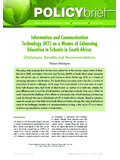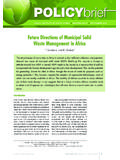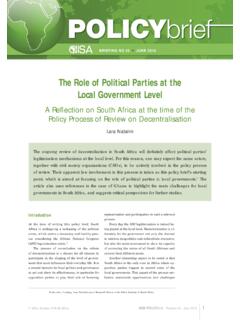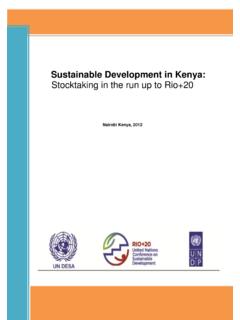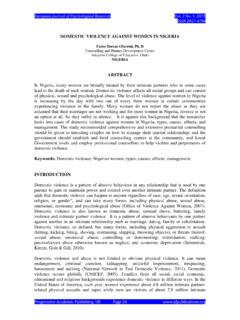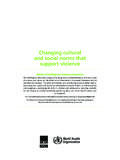Transcription of The Role of Culture in Contributing to the Spread of HIV/AIDS
1 1 Africa Institute of South Africa AISA POLICY brief Number 29 June 2010 BRIEFING NR 2 APRIL 2008 GBRIEFING NO 29 JUNE 2010 The Role of Culture in Contributing to the Spread of HIV/AIDSU nderstanding How Cultural Norms and Practices,Specifi cally female Genital mutilation Facilitate the Spread of HIV/AIDST holoana MofoloThe practice of female genital mutilation is very common in Africa and has also been shown to occur in the West, specifi cally in the USA and the UK. Reasons given for this practice range from ensuring fi delity during marriage; enhancing sexual pleasure for men; observing religious custom; upholding traditional values/rite of passage; and so forth.
2 This practice has received widespread global concern and has resulted in the enactment of various laws advocating for its complete abolition internationally, and in various African countries. This policy brief sets out to explore the role of Culture in its potential contribution to the practice of female genital mutilation , and goes further to articulate the health related hazards and implications of this practice, with specifi c reference to explaining its facilitation to the Spread of HIV/AIDS . Furthermore, the brief makes recommendations encompassing continental integration in the promotion and imple-mentation of eradicating female genital mutilation , and ensuring that harsh punitive measures are put in place for those aware of its dangers yet continuing to have it carried role of Culture has been particularly problem-atic in the fi ght against HIV/AIDS .
3 When one talks of Culture , especially in the context of HIV/AIDS , what comes to mind is the patriarchal society in which we live, as well as the gender inequalities which it has given rise to. This paper will focus on how Culture in general has facilitated the Spread of HIV, with specifi c reference to cultural norms At the time of writing, Tholoana Mofolo was a Research Intern at the Africa Institute of South Africa2 AISA POLICY brief Number 29 June 2010 Africa Institute of South Africa( gender roles and relations) and their potential contribution to the adoption of various practices, such as female genital mutilation , which may, in turn, lead to the further Spread of simple terms, Culture basically refers to the traditions and customs upheld by societies and communities because of their belief systems and values.
4 Culture is defi ned as the learned, shared and transmitted values, beliefs, norms and life ways carried by groups of people, which guides their decisions, thinking and actions in patterned ways. The individual in society is bound by rules of his/her Culture . Cultures are different in that the same events that may be fear-inducing in one Culture may be anger-inducing in A more comprehensive defi nition of Culture is:The pattern of human activity and the symbols that give signifi cance to these activities. Culture manifests itself in terms of the art, literature, cos-tumes, customs, language, religion and religious rituals.
5 The people and their pattern of life make up the Culture of a region. Cultures vary in differ-ent parts of the world. They are different across land boundaries and the diversity in cultures re-sults in the diversity in people around the world. Culture also consists of a system of beliefs held by the people of a region, their principles of life and their moral values. The patterns of behaviour of people of a particular region also forms a part of that region s Culture . The word Culture hails from the Latin word cultura, derived from colere, means, to cultivate.
6 Hence, the way in which the minds of the masses inhabiting a particular region are cultivated, in some way determines the Culture of a roles and relations also constitute some aspect of Culture . These roles and relations arise out of a process of socialisation, where young boys and girls are taught their respective roles in society as well as in relation to one other. In black African Culture , the male fi gure has always held the dominant position in the household. Men in pre-colonial times were hunters and have always been the providers and breadwinners for their families.
7 Women ploughed the fi elds and took care of the household duties which involved cooking, clean-ing and washing clothes, etc. It can be said that men have always maintained a superior status over their wives to some degree. African boys are taught from a young age that they are to provide for their families and are to also be the heads of their households. Young African girls, on the other hand, are socialised to become nurturers and car-egivers to their children and husbands. They are to take care of their families and taught to be hum-ble, as well as respectful to their husbands.
8 This is common knowledge among black Africans and these patterns of socialisation are not only taught, but learned through daily observation within one s family and other black African families. As a result, the gender roles learned and adopted by young boys and girls infl uence the ways in which they relate to one another later in life. Men are labeled provider/head and women caregiver/sub-ordinate and, as a result, begin to internalise and assume these respective roles . It can be argued that these gender differences/inequalities contribute to the Spread of sexually transmitted diseases, such as HIV/AIDS , in that unequal power relations also come to exist when it comes to sexual intercourse.
9 Sex in some tra-ditional African cultures has mainly been for the pleasure of the man. This idea was further emphasised during the Apartheid era when black African men migrated to the urban centres in search of employment in the mines. Men in the mines felt that they worked very hard and con-stantly faced the risk of death as a result of work-ing in highly adverse and dangerous conditions. This, they felt, entitled them to various sexual partners, ultimately creating an opportunity in which to relieve, sexually, the stress and tension they experienced on a daily basis, thus simulta-neously providing an avenue in which to express their Masculinity has been cited as a place in gen-der relations, the practices through which men and women engage that place in gender, and the effects of these practices in bodily expe rience, personality and Culture .
10 4 It has been posited that power imbalance[s] pervade all social relation-ships between men and To contextualise this even more, there is an unequal balance of power between men and their sexual partners an imbalance whose detrimental effects have resulted in [black] women becoming the face of HIV/AIDS , both in Africa and in the Lack of power by African women in relationships means that they have very limited decision-making abilities in the relationship and are unable to negotiate safer sex and, therefore, risk infection to please the This is particularly the case if the woman s husband/partner is the sole breadwinner of the household, or if the woman has a low educational background.
